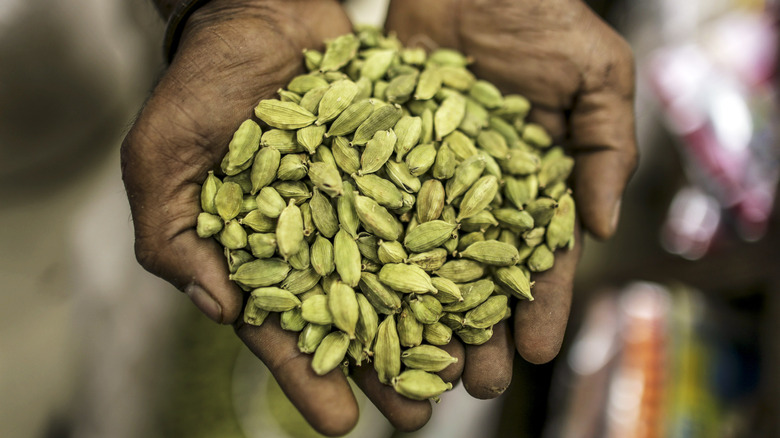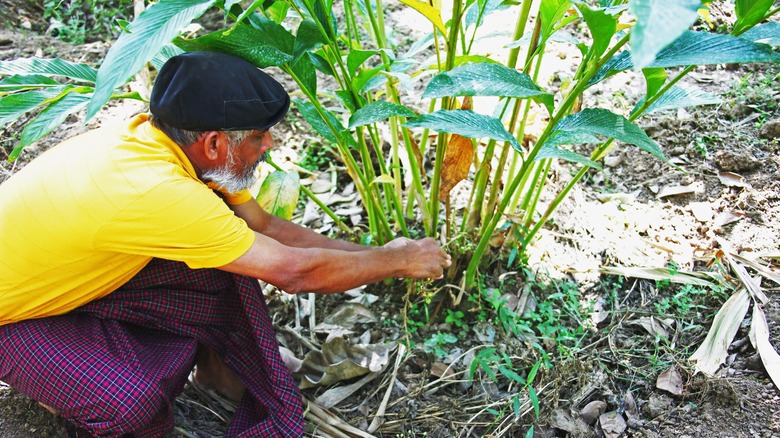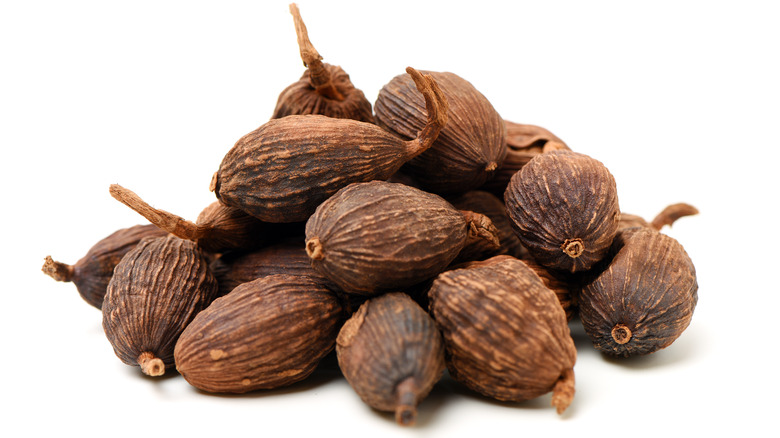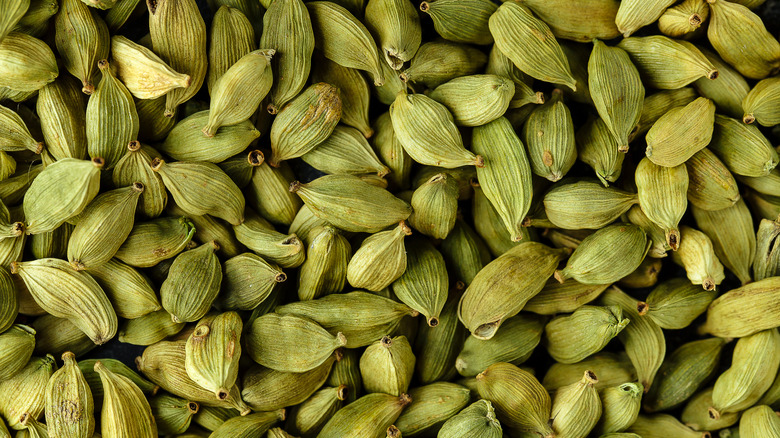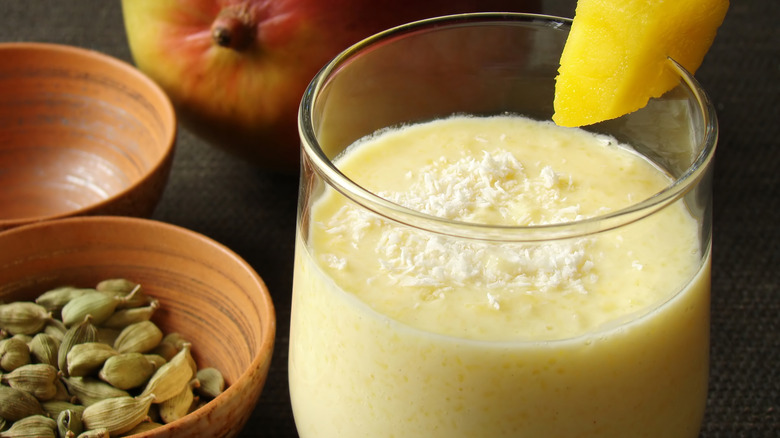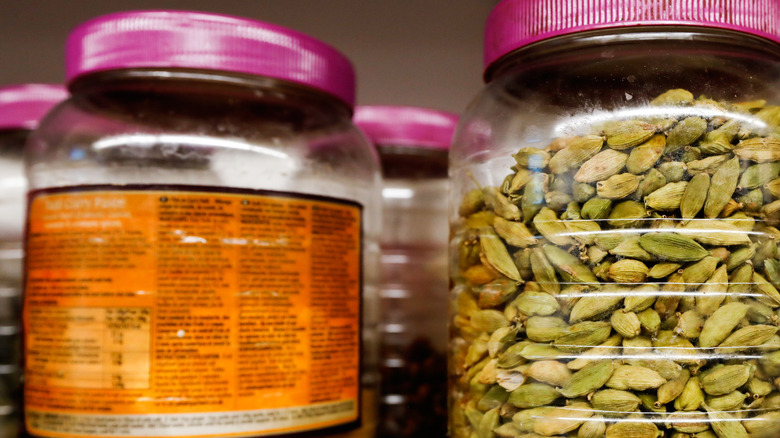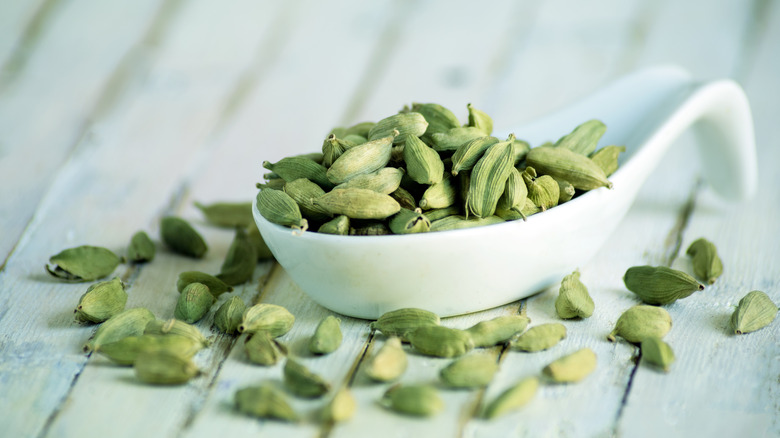What Is Cardamom And What Does It Taste Like?
If you've ever watched any of those baking challenge shows on Food Network, there's a good chance you've heard the contestants refer to cardamom. Perhaps you're unfamiliar with this spice and said to yourself, "Carda what?"
Cardamom may not get the acclaim of cinnamon, nor does it pop up in recipes as often as ginger, but this spice is very much a potent addition to any spice rack. It's certainly a major staple for Samin Nosrat in her kitchen, and you'll likely see it in tons of her recipes in the new cookbook she's working on. And if it's good enough for Nosrat, it's good enough for everyone.
It was first used by the Egyptians as mouth fresheners and later by the Greeks in perfumes, but more importantly, what does this spice taste like and how can you go about using it in your own kitchen? With a comprehensive understanding of the spice, there's no doubt you'll be adding it to your pantry staples.
How cardamom is processed
Cardamom is part of the Zingiberaceae family of plants and primarily comes in two colors (via Gardener's Path). There is green cardamom, Elettaria cardamomum, and black cardamom, Amomum cardamomum. Though expensive for its labor costs, green tends to be the more prevalent of the two kinds of cardamom.
All cardamom comes from small, thin pods that are grown on the plants. The pods have a cross-section inside of them and a thin, papery slip over the outside. Green cardamom specifically tends to grow between five to 10 feet tall with leaves up to two feet long in tropical climates. Once the plant matures after three years, it will flower and produce the seed pods which are harvested in the fall roughly a month after the flowers bloom.
Ripe pods pull away from the plant easily and usually have black seeds on the inside of green cardamom pods. After the pods are harvested, they are dried at a heat no higher than 120 degrees Fahrenheit to ensure their distinct flavor is preserved. Finally, the pods are sold whole or finely ground to customers.
Green cardamom vs. Black cardamom
Black cardamom and green cardamom are far from interchangeable. Green cardamom, which is the more common of the two, uses the whole pod including the seeds. There's even a bleached version of green cardamom known as white cardamom, according to Gardener's Path. But the full pod of black cardamom cannot be used. Instead, only the seeds are harvested and used for this version of the spice (via Food NDTV).
Green cardamom has the vibrant, rich aromatics and flavors most people who are familiar with cardamom would expect. It's the one that is commonly used with other spices such as cinnamon, star anise, and more. But black cardamom has quite a different flavor that actually brings mint to mind, according to Food NDTV. Though both are used to add flavor to dishes and drinks, you typically won't see them used for the same types of dishes.
What does it taste like?
In its raw form, cardamom is a greenish pod that comes from a plant that thrives in the mountainous forests of India. However, they're grown in other warm climates around the world these days including in Guatemala and Sri Lanka, according to Gardener's Path.
As for the taste, that really depends on whether it's green or black cardamom. Green cardamom produces a zesty citrus flavor that can be somewhat sweet and spicy at the same time. Black cardamom, on the other hand, has an almost smoky, minty, menthol-like flavor that works especially well in savory dishes. White cardamom tends to have a more mild flavor. Regardless of the type of cardamom that you opt to use, it's a pretty strong and aromatic spice, and people on the Chowhound message boards seem to agree that a little bit goes a long way.
Considering the price of most cardamom, you'll want to use it sparingly anyway.
How to cook with cardamom
Because it's in the same botanical spice family as ginger and turmeric, cardamom pops up a lot in many Indian and Middle Eastern recipes. It pairs great with both poultry and red meat, and can make an excellent addition to stews and curries. Because of the spice's citrus flavorings, it also works great with cinnamon and pistachios, and is often used in various baked goods. Domestic diva Martha Stewart even likes to use the spice in her mulled wine recipe (via Martha Stewart).
Both black and green cardamom are used in a variety of recipes — however, they're not necessarily interchangeable, and choosing one over the other will really alter the overall taste. The form of the spice that you choose to use can also really affect how strong the cardamom flavoring is, too. The Spice Guide recommends using it in a ground form if you don't want it to be too potent — perhaps for a cake or Swedish coffee bread. If you really want a strong hit of the stuff, going straight for the cardamom pods themselves can deliver a real punch to a pot of herbal tea.
While the ground form of cardamom is made from the seeds within the pods, if you're grinding your own, the pods themselves don't necessarily have to go to waste. Tasty Bite recommends adding them to everything from lemonade to flavored rice.
Remember that depending on the type of cardamom you use and the type of food you're making, you'll get different flavors. It's certainly a fantastic spice to work with, but a dash of it in your pancake batter is going to taste a lot different than if you're adding it to a stew.
Where to buy cardamom
Though many Americans are not quite so used to using cardamom, green cardamom is readily available and can be easily found. Whether you shop at a major grocery store retailer or a small co-op, chances are you'll find cardamom among the other spices. Of course, you can also order it online if you prefer to have your spices shipped to you, per Thrive.
The only time you might need to visit a specialty store or have to order the spice online is if you are looking for a specific, lesser-used variety in the U.S. such as black or white cardamom. If you also have a preferred origin to ensure your cardamom was grown and produced in a certain country or region, you also might have to search a little more.
Once you find your favorite source of cardamom, it isn't hard to reorder or return to the store to replenish your stock of the spice. Especially since it just might become one of your new favorite flavors to use in your cooking.
Nutritional value of cardamom
So we know that this zesty spice has some pretty complex flavors, but it's also worth pointing out cardamom's health benefits. Cardamom hasn't just been used in cooking for centuries — it's also been tapped for its medicinal properties. We don't advise that you start whipping up your own medicines, but you can still reap the benefits of cardamom by cooking with it.
Cardamom has been studied for its effects on possibly reducing blood pressure and helping with weight loss, but one of the more unique aspects is its ability to help fight bad breath. According to Healthline, some cultures would eat entire cardamom pods to combat bad breath because of the spice's ability to fight cavity-causing bacteria. Wrigley's gum has even used it in their products.
As for nutritional values, Medical News Today reports that one tablespoon of ground cardamom has 18 calories, 0.4 grams of fat, four grams of carbs, 1.6 grams of fiber, and 0.6 grams of protein. It's also a source of vitamins and minerals such as potassium, calcium, magnesium, and phosphorus, among others. So pick up some cardamom to add to your dishes. You just might find you really enjoy it.
